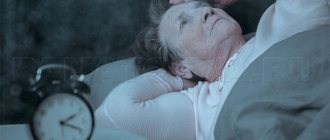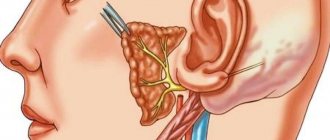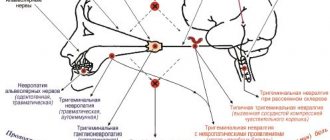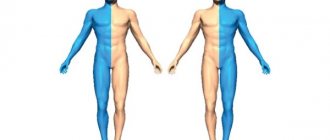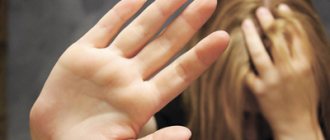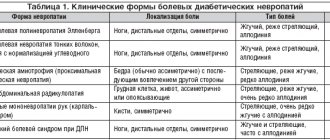Causes
There are many reasons for the development of cerebral palsy. The most common ones should be highlighted:
- Intrauterine brain damage
- Hypoxia during childbirth
- Intoxication
- Somatic and endocrinological diseases of the mother
- Rhesus conflict between mother and child
- Anomalies of labor (including birth injuries)
- Past infections
Under the influence of these and other reasons, direct damage to brain tissue occurs, and disturbances in its development processes begin to form. In this case, special attention should be paid to infectious diseases of the mother, which, today, account for more than half of all causes of cerebral palsy in a child.
Morphological changes in brain tissue are varied. Often, a child develops hemorrhages in the interthecal spaces and the brain tissue itself, degeneration of the structures of the cerebral cortex, and cicatricial changes occur. The lesion often affects (but is not limited to) predominantly the anterior parts of the brain.
Symptoms (forms of cerebral palsy)
The symptoms of cerebral palsy vary greatly. Based on the clinical picture, it is customary to distinguish several different forms of cerebral palsy, each of them will be discussed below.
— Hemiplegic form is the most common form of development of cerebral palsy. Its development is associated with damage predominantly to one of the cerebral hemispheres. In this case, the symptoms of the disease are as follows: paresis of the limbs develops on one side, contractures of the joints of the arms and legs are observed. The muscle tone is increased according to the pyramidal type. In the neurological status, attention is drawn to an increase in all tendon reflexes; pathological reflexes are often caused. Most often, the severity of the phenomena is greater in the arm than in the leg. During active movements, frequent synkinesis attracts attention - hand movements to the side, violent movements. The limbs on the affected side are developmentally delayed. Also quite often, this form of cerebral palsy is accompanied by the development of symptomatic epilepsy and mental development disorders.
— Diplegic form (Little's disease). It is a variant of cerebral palsy, expressed in spastic paresis of mainly the lower extremities. The child is clearly lagging behind in motor development; often such children never begin to walk independently. At the same time, a pronounced increase in muscle tone in the calf muscles makes the gait of such patients very peculiar: patients rely only on their fingers, their knees touch each other while walking, and it seems as if the patient is about to fall forward. This sign is so bright that it allows one to diagnose this form of cerebral palsy at a distance. The neurological examination also shows increased reflexes and pathological foot signs. In most cases, intelligence suffers little.
— The hyperkinetic form develops with damage to the subcortical ganglia (often with Rh conflict). Among the symptoms of the hyperkinetic form of cerebral palsy, hyperkinesis itself comes to the fore - violent movements such as athetosis, chorea, etc. Usually hyperkinesis is varied, but one of them is still of leading importance. As the child grows and develops, the nature of hyperkinesis may change.
— The atonic-astatic form is manifested by a decrease in muscle tone of all extremities and the inability to maintain a vertical posture. Motor skills are practically not developed. Dysarthria often occurs.
— A rare cerebellar (atactic) form develops with predominant damage to the cerebellum. Vestibular disorders, ataxia, disorders of gait and coordination of movements acquire leading importance.
Early signs and symptoms of the static form of cerebral palsy
The first signals can be seen already in the process of development in the first year of life.
- If you pull a child's hand, his muscles will not tense, he remains passive.
- The head is thrown back, the legs are either bent at the hip area and raised, or are in an extended state.
- Atonic asonic form of cerebral palsy
- When a child lies on his back, he does not try to move and looks lethargic. The tone of his muscular system is extremely reduced. The arm muscles work better than the leg muscles, and the child is more active in the upper body.
- Does not reach out to the toy; stereotypical motor activity is observed in the hand area: repeatedly repeated movements that have no purpose.
- Tendon reflexes are intensely expressed. The child cannot hold his head up when hanging vertically. It begins to hold its head only in the second half of life.
- Does not roll over and cannot perform other actions (cannot hold a toy in his hand, has poor control of movements).
- In a position on his stomach, he cannot hold his head up or support himself with his arms, so for a long time he does not learn to crawl. Some children begin to move, leaning on their hands and pulling their legs towards them, while others do not experience reciprocal movements of their arms and legs when crawling.
- There is no interest in toys for a long time (a consequence of mental disorders).
- Unable to sit without support in the second half of life. Children begin to sit independently only in the second year, but it is difficult for them to maintain balance, the pose looks unstable.
- The ability to stand and walk is formed only at 7-9 years of age. The legs are wide apart, the gait is shaky, the arms are not used to maintain balance. Most children cannot walk for a long time, and when the environment changes, problems with movement arise.
- Most children suffer from mental disabilities, show aggression, and emotional reactions are weakly expressed.
- Half of the children have seizures. Strabismus, glaucoma, and nystagmus may also be observed. Intense trembling of the limbs appears.
Diagnostics
Diagnosis of the disease is usually based on the presence of a cause that led to cerebral palsy, as well as the clinical picture and neurological status. In modern medicine, neuroimaging methods such as MRI and MSCT are also important, but their use is limited by the need for anesthesia during the study. *MRI image for cerebral palsy
Also, in the presence of symptoms such as epileptic seizures, delayed mental and motor development, research methods such as EEG, Echo-EG, psychological testing, etc. can be useful.
Features of rehabilitation of children with generalized forms of hyperkinesis
Based on the concept of a specific response to a nonspecific stimulus, we can recommend techniques that facilitate the rehabilitation of such children. 1. Tractional rotational manipulation technology is performed on all children with hyperkinesis, although its implementation in the first days causes certain difficulties. Hyperkinesis of the head and individual limbs can be easily corrected, and sometimes stop even after a week-long course of procedures. In generalized forms of hyperkinesis, only 10% of children manage to eliminate chaotic movements immediately after the first course of traction rotational manipulation technology. After the procedures, the remaining children experienced improved sleep, easier movements, and the appearance of high-amplitude modeled movements. After the first course of intensive rehabilitation, all children with hyperkinesis experience accelerated growth and development. But, some time after the first course of procedures, the growth of the vertebrae in length leads to an increase in compression of the roots or overstretching of the dura mater around the nerve roots, which can manifest itself in the form of resumption of hyperkinesis. Unlike a relapse, renewed hyperkinesis will never achieve the same phenomena that were observed before the first course of procedures. The purposeful movements that the child learned after the first course of rehabilitation are preserved. The fact of increased hyperkinesis indicates the need to repeat a short course of traction rotational manipulation technology. After repeated 5-7 procedures, the phenomena of hyperkinesis decrease even more than after the first course of procedures. During the treatment period, it is very important not to miss the moment of facilitating movements in order to develop the skills of coordinated movements until the growth and development of the vertebrae leads to a new manifestation of the hyperkinesis clinic.
| Back | Table of contents | Further |
Course of the disease and life prognosis
Cerebral palsy, especially at an older age, is not a progressive disease, but the presence of persistent residual consequences of brain damage. In this case, as a rule, there is regression of symptoms to one degree or another. The possibilities for compensating for impaired functions are quite large in early childhood, and sometimes make it possible to achieve almost complete recovery.
It is difficult to assess the signs of cerebral palsy at three months of age, or, say, at the age of 6 months. The phenomena of developmental delay and signs of paresis of the limbs come to the fore. However, each case is individual, and it is impossible to identify the exact signs of cerebral palsy in the first year of life.
The life prognosis of patients with cerebral palsy is usually favorable. Patients live to a ripe old age and can have offspring. A decrease in average life expectancy is often associated with mental underdevelopment, lack of social adaptation, as well as the frequent presence of symptomatic epilepsy.
Treatment
Therapy for cerebral palsy is a multifaceted task. It must be comprehensive and include medications, physiotherapy, psychotherapy, speech correction, massage, the use of special orthopedic devices, and physical therapy.
— Among drug therapy, the most important is given to neuroprotective drugs (Cortexin, Actovegin, Cerepro), as well as muscle relaxants (baclofen, mydocalm) to relieve spasticity. Vitamin and other metabolic drugs are widely used. If necessary, sedatives are used. The presence of symptomatic epilepsy presupposes the use of antiepileptic drugs.
— Physiotherapy, physical therapy, massage are aimed at reducing the lag in motor development. Also, activation of motor function helps to improve the mental development and social adaptation of a patient with cerebral palsy.
Recently, methods of treating cerebral palsy such as hippotherapy (treatment with contact with horses) have become fashionable. However, these techniques are not always available and, as a rule, expensive, so they are not widely used.
Cerebral palsy, atonic-astatic form: treatment
An obligatory part of the treatment is the effect on the muscles. We are talking about classic and acupressure massage. Some children are prescribed acupuncture. Physical therapy has a beneficial effect on the patient’s condition if he is able to move independently.
Drug treatment is used. Children are prescribed medications that improve muscle condition, increase their tone, and eliminate cramps, if any. Some specialists resort to hippotherapy. Horseback riding has a positive effect on muscles and on keeping the body in balance.
Metameric treatment methods have proven their effectiveness. Metameric technologies are based on a combination of acupuncture of gradient zones (zones of maximum biological activity) of the affected metamer with the simultaneous administration of drugs that have neuroprotective and neuroregenerative effects.
The effect of treatment is enhanced by metameric massage, the essence of which is to influence certain areas of the body. Metameric therapy is developed strictly individually for each patient. An individual approach is the key to success in this case.
With the right approach to diagnosis and therapy, the negative impact of the disease on the child can be reduced. The main thing is to detect the disease in time and contact a specialist without delay. In order not to waste precious time, it is recommended to undergo preventive examinations with a pediatric neurologist.
